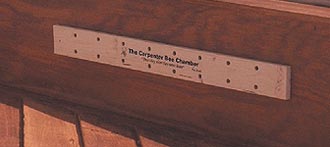 If you’ve noticed these large insects resembling bumblebees buzzing around your home, chances are they’ve had a chance to drill into nearby wooded structures to nest. They are solitary creatures that do not create large hives, but if unchecked can pose a nuisance to log homeowners. Though the males have no stingers, they tend to dive bomb unsuspecting humans near the brood holes, which can be disconcerting.
If you’ve noticed these large insects resembling bumblebees buzzing around your home, chances are they’ve had a chance to drill into nearby wooded structures to nest. They are solitary creatures that do not create large hives, but if unchecked can pose a nuisance to log homeowners. Though the males have no stingers, they tend to dive bomb unsuspecting humans near the brood holes, which can be disconcerting.
Carpenter bees do not eat wood like termites and carpenter ants, so cedar’s natural oils that help it resist other insects is not as effective. Rather, the bees bore single holes slightly less than ½ inch in diameter to lay their larvae. The holes enter the wood perpendicularly to the grain then make a 90-degree turn and continue on for several inches to create a gallery where the female will lay 6-10 larval brood cells. Carpenter bees will re-use galleries for future broods and will also seek shelter there in winter months. Each female will bore several galleries in the course of a season for her broods.
environmentally friendly solution: the Carpenter Bee Chamber. This inexpensive, re-usable wooden unit offers the carpenter bee pre-drilled holes that attract the species. Once inside, the female bees stick to the advanced adhesiveThough there are chemical pesticides designed specifically for carpenter bees, Perma-Chink Systems offers an inside the holes and die before being able to lay a brood. The Carpenter Bee Chambers come in two types: a fascia unit or a soffit unit and are easily attached with a screwdriver.
In most areas of the country carpenter bee activity begins in early spring, typically mid-March to early April. It’s important to get the Carpenter Bee Chamber in place as soon as you notice any activity. Although the Carpenter Bee Chamber can be stained to match your home, it is highly recommended that they be left bare since carpenter bees prefer to infest bare wood. At the end of carpenter bee season, usually mid to late June, you can remove the chamber, clean it out and store it until next season. For more information click here.
